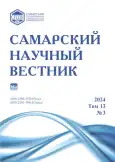Пломбы Российской империи во второй половине XVIII века: результаты археологических исследований в Москве
- Авторы: Дёмин М.В.1, Петухов С.П.2
-
Учреждения:
- Общество с ограниченной ответственностью «Археология Восточно-Европейской равнины»
- Общество с ограниченной ответственностью «Археологические изыскания в строительстве»
- Выпуск: Том 13, № 3 (2024)
- Страницы: 118-122
- Раздел: Исторические науки
- URL: https://journal-vniispk.ru/2309-4370/article/view/280750
- DOI: https://doi.org/10.55355/snv2024133204
- ID: 280750
Цитировать
Полный текст
Аннотация
Статья посвящена краткому обзору сфрагистического материала Российской империи второй половины XVIII века, обнаруженного в ходе археологических раскопок в историческом центре г. Москвы по адресам: площадь Павелецкого вокзала; ул. Варварка, д. 3 («Старый» Гостиный двор); ул. Садовническая, д. 3/7; ул. Ильинка, д. 3/8 («Теплые» Торговые ряды); туп. Сытинский, д. 3 А; пер. Молочный, владение 3 в 1996–2009 гг. Пломбы Российской империи представляют собой значимые артефакты и являются ценным источником информации, свидетельствующим о развитии национальной промышленности, экономики, а также внешней и внутренней торговли. Сфрагистический материал представлен двумя видами пломб: «буллы» и «заклепки с перемычкой». «Буллы» представляют собой круглые или овальные пломбы, часто с изображением гербов или символов власти, что подчеркивает их официальный характер. Они могли использоваться как для упаковки товаров, что делало их важным элементом в системе торговли, так и для официальной документации. Заклепки с перемычкой, в свою очередь, служили для закрепления упаковки и защиты содержимого от несанкционированного доступа. Такие пломбы часто имели уникальные знаки или символы, что позволяло идентифицировать производителей или владельцев товаров. Исследование этих артефактов не только помогает понять экономические и торговые практики, фискальные процедуры того времени, но и освещает культурные и социальные аспекты жизни в Российской империи. Сфрагистический материал является важным элементом в реконструкции исторического контекста, а его анализ может дать новые знания о взаимодействии внешней и внутренней экономики и развитии государственной власти.
Ключевые слова
Полный текст
Открыть статью на сайте журналаОб авторах
Максим Викторович Дёмин
Общество с ограниченной ответственностью «Археология Восточно-Европейской равнины»
Автор, ответственный за переписку.
Email: maxim.demin@mail.ru
заместитель директора по производству
Россия, г. МоскваСергей Павлович Петухов
Общество с ограниченной ответственностью «Археологические изыскания в строительстве»
Email: 134645psp@rambler.ru
ведущий специалист-археолог
Россия, г. МоскваСписок литературы
- Москва // Советская историческая энциклопедия. Т. 9 / гл. ред. Е.М. Жуков. М.: Советская энциклопедия, 1966. С. 706–723.
- Ковальчук А.В. Москва как крупнейший текстильный центр России во второй половине XVIII века // Отечественная история. 1996. № 6. С. 3–18.
- Заозерская Е.И. Развитие легкой промышленности в Москве в первой четверти XVIII в. М.: Изд-во Академии наук СССР, 1953. 516 с.
- Сытин П.В. История планировки и застройки Москвы: материалы и исследования. Т. 1. 1147–1762. М.: Тип. изд-ва «Московский рабочий», 1950. 416 с.
- Кафенгауз Б.Б. Очерки внутреннего рынка России первой половины XVIII века (по материалам внутр. таможен). М.: Изд-во Академии наук СССР, 1958. 355 с.
- Неболсин А.Г. Законодательство о фабричных и торговых клеймах в России и Заграницею. СПб.: Тип. В.Ф. Киршбаума, 1886. 250 с.
- Рожкова М.К. Промышленность Москвы в первой четверти XIX века // Вопросы истории. 1946. № 11–12. С. 89–103.
- Розен Я.С. Товарные знаки: законы и применение их в административной и судебной практики, законодательные мотивы и решения Правительственного Сената, трактаты и декларации. СПб.: Изд. Юридического книжного склада «Право», 1913. 183 с.
- Уздеников В.В. Монеты России. 1700–1917. 2-е изд., перераб. и доп. М.: Совмест. сов.-герм. предприятие «Межнумизматика», ДатаСтром, 1992. 677 с.
- Векслер А.Г. Отчет об охранных археологических работах в Москве в 1996 г. Книга 7. Охранные археологические работы, связанные с реконструкцией Гостиного двора в 1996 г. // Архив Института археологии РАН (Архив ИА РАН). Р-I. № 20410.
- Векслер А.Г. Отчет о спасательных археологических работах, связанных со строительством многофункционального административного комплекса по адресу: наб. Садовническая, вл. 3–7 в 2006 г. // Архив Управления сохранения ОАН Мосгорнаследия. АО-948 Т1–3.
- Векслер А.Г. Отчет о проведении охранных археологических работ на объекте по адресу: г. Москва, ул. Ильинка, д. 3/8, стр. 3, 4 и Богоявленский пер., д. 6, стр. 1 (Теплые Торговые ряды) в 2008 г. // Архив ИА РАН. Р-I. № 28913 Т1. № 28914 Т2.
- Ковальчук А.В. О государственной власти и частном промышленном предпринимательстве в России во второй половине XVIII в. (текстильная промышленность Москвы) // Система государственного феодализма в России. Вып. 1. 1993. С. 180–207.
- Векслер А.Г. Отчет об охранных археологических исследованиях в г. Москве в 2001 г. Т. 2. Археологические исследования в Земляном городе. Ч. 1. Отчет об охранных археологических исследованиях в режиме наблюдений, связанных со строительством по адресу: Молочный пер., вл. 3 в 2001 г. // Архив ИА РАН. Р-I. № 23538.
- Петров А.Ю. Российско-американская компания // Большая российская энциклопедия. Т. 28. М.: Большая российская энциклопедия, 2015. С. 681–682.
Дополнительные файлы









